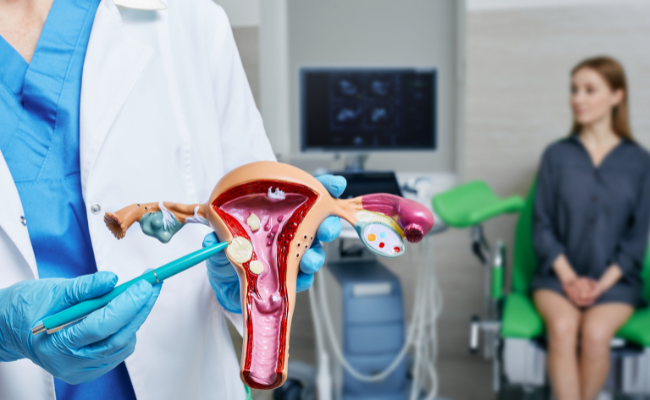How to Treat Uterine Lesion?
- December 12, 2023
- No Comments

What are Uterine Lesions?
Uterine lesions encompass abnormal growths or tissue changes within the uterus, including polyps, fibroids, and tumors. These conditions, often non-cancerous, can lead to symptoms such as pelvic pain and abnormal bleeding. Diagnosis involves thorough examination and imaging, with treatment options ranging from observation and medication to minimally invasive procedures and surgery. The management approach is tailored to the specific characteristics of the lesions, aiming to alleviate symptoms and preserve reproductive health based on individual needs and preferences.
Why Do Uterine Lesions Occur?
The development of uterine lesions can be attributed to several factors, including hormonal imbalances, genetic predisposition, and certain medical conditions. Hormonal fluctuations, especially during reproductive years, can contribute to the growth of abnormal tissue in the uterus. Additionally, genetic factors may make some individuals more susceptible to uterine lesions. Conditions such as endometriosis and adenomyosis can also play a role in the formation of these lesions.
How are Uterine Lesions Diagnosed?
The diagnosis of uterine lesions typically involves a combination of medical history assessment, physical examination, and imaging studies. Women experiencing symptoms like abnormal bleeding, pelvic pain, or changes in menstrual patterns should seek prompt medical attention. Gynecologists often perform pelvic exams to detect abnormalities, and imaging techniques such as ultrasounds and MRI scans provide detailed insights into the structure of the uterus.
Treatment Solutions for Uterine Lesions:
Effective management of uterine lesions requires a tailored approach based on the type, size, and symptoms associated with the lesions. Several treatment options are available, ranging from conservative measures to more invasive interventions.
- Observation and Monitoring: In cases where uterine lesions are small, asymptomatic, or not causing significant issues, a "watch and wait" approach may be recommended. Regular monitoring through imaging studies can help track any changes in the size or characteristics of the lesions over time.
- Medication: Hormonal medications, such as birth control pills or hormonal intrauterine devices (IUDs), may be prescribed to regulate menstrual cycles and reduce symptoms associated with uterine lesions. These medications can help manage pain, control bleeding, and slow down the growth of certain types of lesions.
- Minimally Invasive Procedures: For more significant lesions, minimally invasive procedures may be considered. Endometrial ablation, for example, involves the removal or destruction of the uterine lining and is often used to treat conditions like polyps. Similarly, hysteroscopic removal can be employed for the excision of smaller lesions using a thin, lighted tube inserted through the cervix.
- Uterine Artery Embolization (UAE): UAE is a non-surgical procedure that involves blocking the blood vessels that supply blood to uterine fibroids. By cutting off the blood supply, the fibroids shrink, relieving symptoms. This approach is particularly beneficial for women who wish to preserve their uterus and avoid surgery.
- Surgical Interventions: In cases where lesions are large, causing severe symptoms, or if there is a suspicion of malignancy, surgical removal of the lesions or, in some cases, a hysterectomy (removal of the uterus) may be recommended. Surgical interventions are often considered when other conservative measures prove ineffective.
Benefits of Treating Uterine Lesions:
- Symptom Relief: Effective treatment of uterine lesions can provide significant relief from symptoms such as pelvic pain, abnormal bleeding, and menstrual irregularities. This improvement in symptoms enhances the overall quality of life for affected individuals.
- Preservation of Reproductive Health: For women who desire to maintain their fertility, certain treatment options, such as minimally invasive procedures or medication, can address lesions while preserving the uterus. This is particularly important for those who wish to conceive in the future.
- Prevention of Complications: Timely intervention and treatment can prevent the development of complications associated with uterine lesions, such as anemia due to excessive bleeding or complications related to the compression of nearby organs.
- Enhanced Emotional Well-being: Living with uterine lesions can be emotionally challenging, especially if the symptoms impact daily life or reproductive plans. Successful treatment not only addresses physical symptoms but also contributes to emotional well-being and a sense of control over one's health.
- Reduced Long-Term Risks: Addressing uterine lesions in their early stages can reduce the risk of long-term complications, including the development of cancer in certain cases. Regular monitoring and appropriate interventions can mitigate potential risks associated with untreated lesions.
Comments (0)